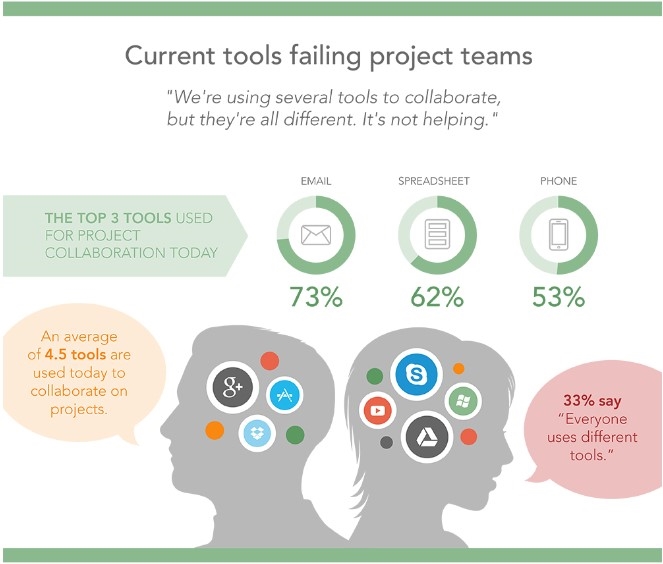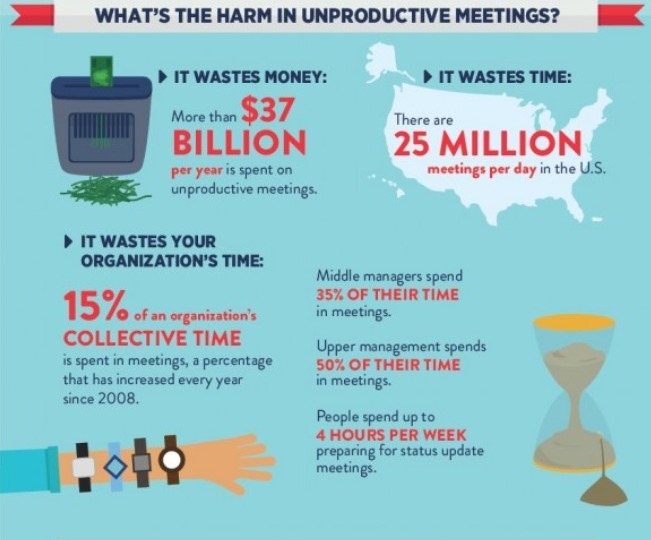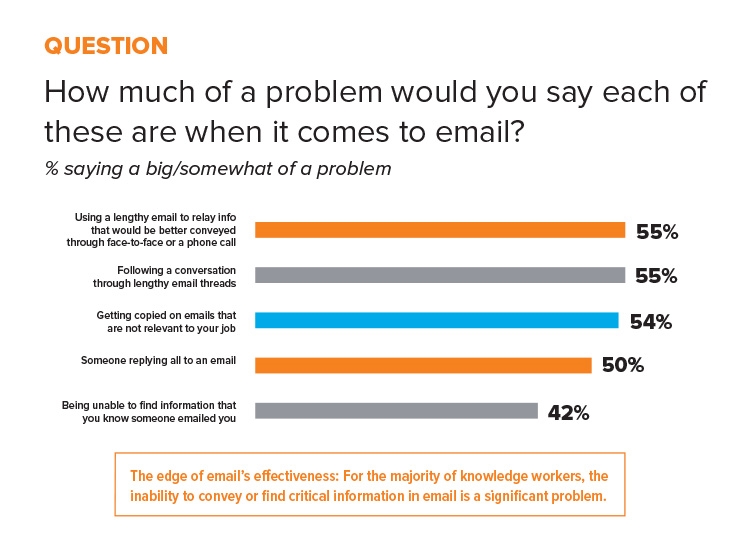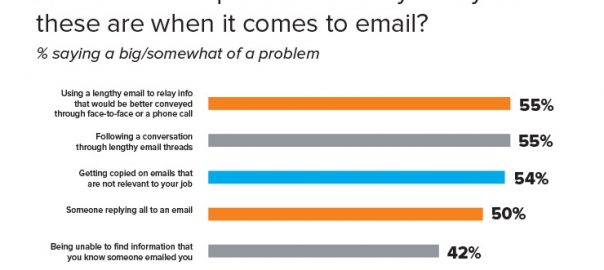— December 27, 2018
Thanks to the technological advancements in the workplace, collaboration is now easier than ever and teams of all sizes can reap the benefits of collaboration tools, such as increased productivity and more time to do meaningful work.
However, too much of anything can never be a good thing, and research has shown that too much collaboration can be just as harmful as too little of it. On the other hand, striking the right balance can skyrocket your team’s performance and efficiency. Here are some of the ways you can make that happen.
Can collaboration really be bad?
In essence, collaboration in the workplace is a noble cause, as two heads think better than one. There’s science behind this claim too, as a Stanford study has shown that workers who collaborated spent 64% more time on their tasks than their counterparts who worked alone. Moreover, they reported increased engagement, more success in their work, as well as lower fatigue. In another study by the Institute for Corporate Productivity, it was shown that companies where workers collaborate are 5 times more likely to perform well.
Clearly, collaboration cannot be a bad thing, right?
According to Harvard Business Review, there’s such a thing as collaboration overload. Their findings suggest that over the past 20 years, collaborative activities in companies doubled. What’s more, for some employees, they spend 80% of their time at work collaborating. Finally, the most compelling data states that 20-35% of value-added collaboration comes from just 3-5% of all employees.
It turns out that collaboration can be extremely beneficial for productivity, but only in the right amounts. Here’s how to strike the perfect balance so that you’re collaborating just enough to be at your most productive.
Don’t miss an update!Have every post delivered directly to your inbox
Thanks for your interest in Chanty!
Be picky about your tools
We live in a beautiful time when there’s an app for everything. Every day there’s a new startup with an app to make team collaboration more efficient and increase productivity. As much as this is a good thing, it can lead to situations where you’re using too many tools and employees get scattered all over the place.

In reality, a handful of apps should be enough to do the job. You can use a team communication app such as Chanty, a project management tool such as Trello, an online office stack such as G Suite and perhaps a tool for video meetings like Zoom.
By only focusing on a select few tools, you can streamline your collaboration and communication so that your team members know which tool is the go-to choice for which type of collaboration. For example, important communication goes through email, quick messages are sent in Chanty, task-related information goes in Trello, etc.
Cut down on meetings
Have you ever heard someone wishing they had more meetings? Me neither. Whether we like them or not, meetings are one of the staples of the modern workplace, from two-person startups to multinational corporations. They increase productivity and allow for easier collaboration between people and departments. However, they get their bad rep for a reason.

For starters, 15% of the total organization’s time is lost on meetings, and this number keeps increasing by the year. Depending on your position, you’ll end up spending up to half of your total time at work on meetings (in upper management positions), and up to 4 hours on average just to prepare for meetings.
This wouldn’t be so alarming if it weren’t for the fact that 67% of all meetings are unproductive for various reasons. Participants admit to daydreaming, multitasking, checking their email, doing work unrelated to the meeting, and being absent in general.
While meetings can be a great way to foster collaboration, they also contribute to its overload. Here are some of the things you can do to make them better.
Invite only the relevant stakeholders. If someone doesn’t need to be present, they’re most likely to wander off during the meeting.
Create an agenda and stick to it. If your meetings are structured, you won’t be tempted to go outside of your schedule.
Do one thing only. Ask your participants to focus on the meeting only, without checking their phones or emails or doing other work.
Don’t spend too much time on them. Since 2000, the average meeting length has increased by 10% every year, and it’s now 31 to 60 minutes. Always aim for shorter meetings to hold participants’ attention.
Simplify the way work gets done
According to another Harvard Business Review research, the top most productive companies worldwide lose 50% less time than the rest, thanks to cutting out unnecessary collaboration. They didn’t do this through simple hacks – instead, a thorough behavioral change was required.
These companies achieved more efficiency in their collaboration by cutting down the number of stakeholders. Namely, the more people are in charge of making a decision in an organization, the longer the process takes and there’s an increased need for collaboration.
In order to cut through the noise, make your organization as lean as possible, involving only the relevant stakeholders in the decision-making process.
Spend less time on email
Much like meetings, most of us don’t really love work emails, but they’re a necessary part of the game. Here’s a few alarming stats, starting with this one – on an average, you’ll spend 28% of your week at work going through email, which makes for about 11 hours. You’ll send and receive about 124 emails per day, a little over 600 weekly.

On its own, you could say that this is not such great news, but no cause for alarm. However, research shows that workplace distractions such as email go way beyond the task itself. Namely, it takes 23 minutes to refocus our attention once we’re interrupted – by email, for example, several hundred times per week.
By doing a bit of calculation, we get to the figure of 1,048 hours every year spent on email and refocusing our attention. And that’s just email – imagine how much time is spent refocusing after meetings, coworkers interrupting us in the office, messages on team chat apps etc.
As email is a large part of the collaboration equation, you cannot eliminate it completely, but there are a few ways to spend less time on it.
First, dedicate specific times for email. Once or twice per day, in the morning or afternoon, take a block of time and dedicate it to email only. At all other times, turn off your notifications. If something is urgent, the person who needs you can call you.
Second, don’t send emails to people who don’t need to read them. Don’t CC and BCC large groups of people and don’t send emails to addresses such as sales@company.com so that everyone in the department gets them. Send your emails only to people who really need to read them, and encourage your coworkers to do the same.
Touch emails only once. As you read an email, reply to it immediately instead of leaving it up for later. You’ll have to re-read it and spend additional time on it, which adds up on a weekly and monthly basis.
Leverage emails fully. In many cases, a half-hour meeting can be replaced by a nicely written email, containing the right information and sent to the right people.
Learn how to say no
Much of the over-collaboration happens because we are compelled to instantly reply to each email, check each Chanty message, join every meeting we’re asked to attend. As you can see, the meetings we need to attend and messages we need to respond to take up so much of our time at work that it’s a wonder that we have time to do actual work.
Instead of forcing employees to actively participate in all collaboration at all times, empower them to say no when they need to focus on their own workload. By doing this, you’ll be able to achieve two things.
First, you will instill confidence and trust in your team members so that they can balance their workload on their own. Second, you’ll cut down on unnecessary communication and focus on work primarily.
Conclusion
Collaboration is the magic ingredient necessary to increase your team’s productivity and improve your processes. The key to effective collaboration is knowing how to dose it – too little or too much will do more harm than good and make your team lose precious time and resources. By using these bits of advice, you’ll be able to tweak your collaboration to just the right amount and achieve more with your team.
Do you have any more tips for preventing over collaboration? Do let us know in the comments, we would love to hear your thoughts!
Business & Finance Articles on Business 2 Community
(110)
Report Post







